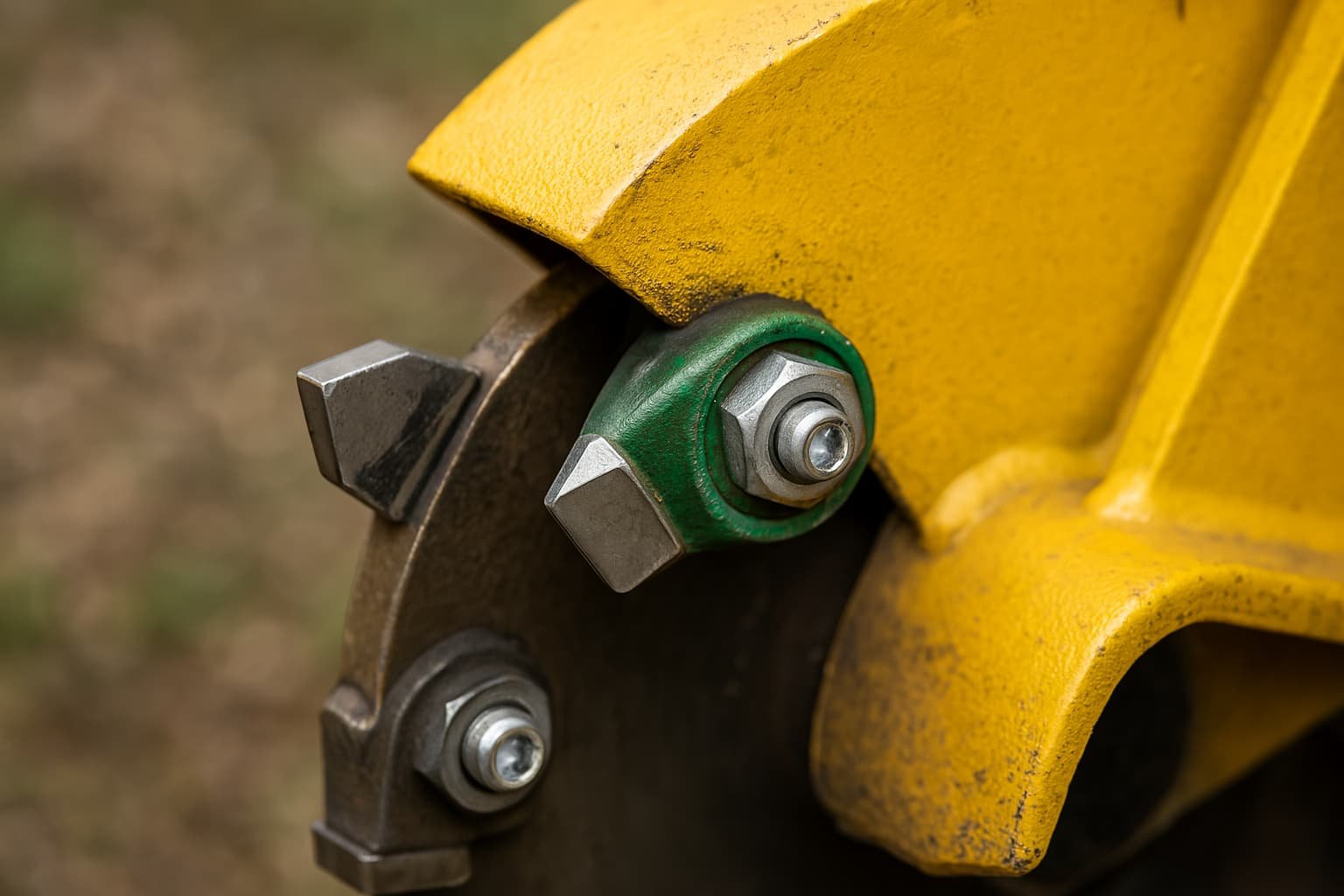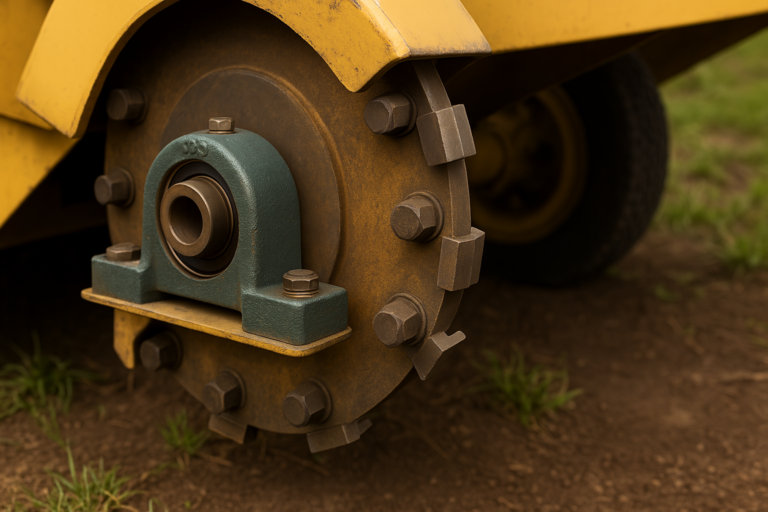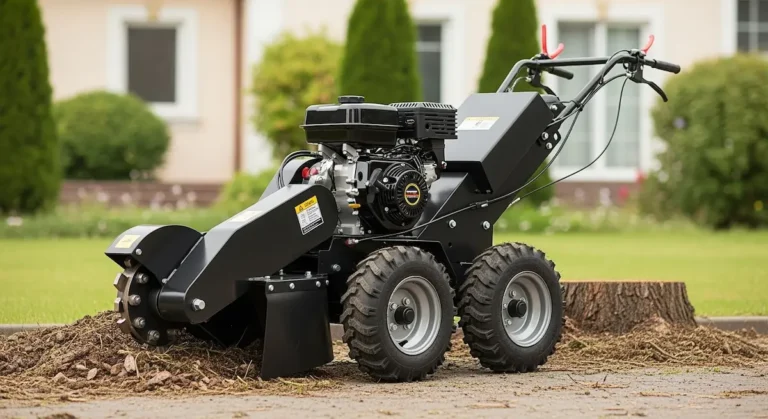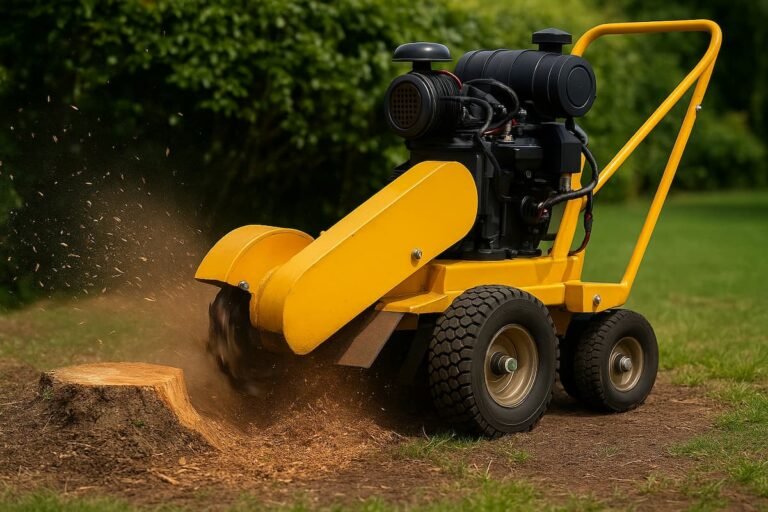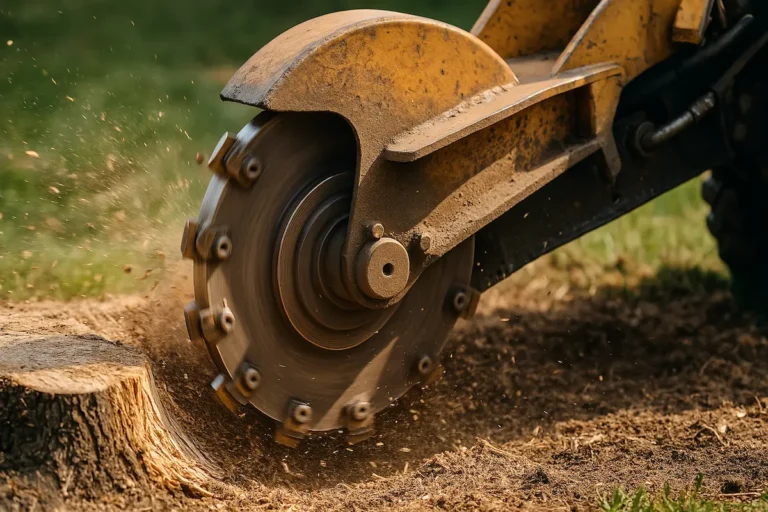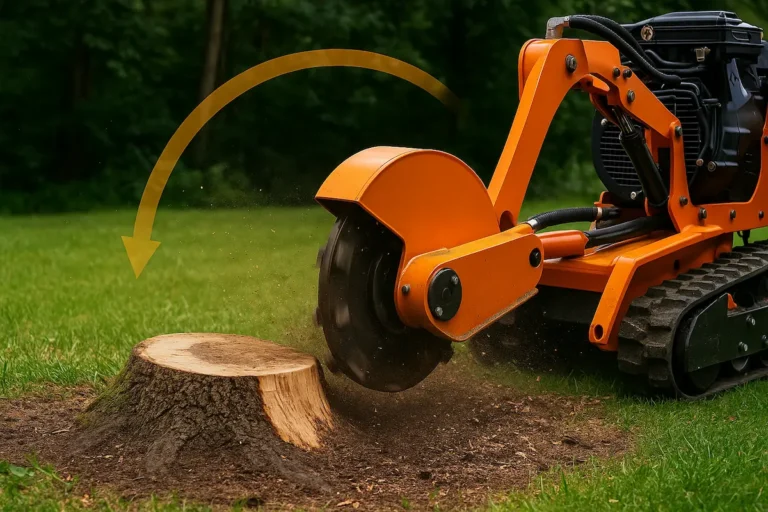Green Teeth for Stump Grinders: The Ultimate Guide for UK Professionals and Hirers
Are you wondering about Green Teeth for stump grinders?
They are special cutting teeth made by a company called Green Manufacturing.
These teeth help grind stumps faster and last longer.
They are very popular with tree experts and people hiring grinders.
Green Teeth vs. Standard Teeth: Feature Comparison
Chart Data: Green Teeth vs. Standard Teeth Feature Ratings (out of 10)
| Feature | Green Teeth Score | Standard Teeth Score |
|---|---|---|
| Speed | 8 | 6 |
| Lifespan | 9 | 3 |
| Ease of Maintenance | 9 | 4 |
| Lower Initial Cost | 4 | 8 |
| Long-Term Value | 9 | 5 |
Key Takeaways
- Performance & Efficiency: Green Teeth generally offer faster grinding speeds and significantly longer lifespan due to their 3-sided rotatable design.
- Maintenance: Changing or rotating Green Teeth is considerably easier and faster compared to standard teeth, reducing machine downtime.
- Cost Consideration: While Green Teeth have a higher initial purchase price, their extended life and time savings often result in better long-term value for professionals.
- Durability: Both types are vulnerable to damage from rocks, but the easy rotation of Green Teeth can mitigate the impact of minor edge damage.
What Exactly Are “Green Teeth” in Stump Grinding?
Okay, let’s clear this up first.
“Green Teeth” aren’t usually green in colour.
It’s the brand name for a very popular type of stump grinder tooth.
A company in America called Green Manufacturing, Inc. makes them.
Think of it as ” Hoover” for vacuum cleaners—a well-known brand.
The main idea is clever and straightforward.
Each Green Tooth is a small, very hard cutting piece, usually made of carbide.
It sits in a special holder called a pocket.
The clever bit is that each tooth has three sharp cutting edges.
When one edge gets blunt from grinding, you don’t throw the tooth away.
You loosen a bolt, turn the tooth to a fresh, sharp edge, and tighten the bolt again.
This makes the tooth last much longer than older styles.
These teeth and pockets work together as a system.
This system is famous in the world of tree care and landscaping.
People choose them because they cut well and are easy to look after.
Unlock Peak Performance: Why Choose Green Teeth for Your Stump Grinder?
So, why do so many professionals choose Green Teeth?
There are three big reasons people switch to this system:
- Faster Grinding: They often cut through stumps quicker than standard teeth. This saves time on the job.
- Longer Life: Because you can rotate a tooth three times, one lasts much longer, saving money on replacements.
- Easy Changes: Swapping or rotating teeth is super quick and straightforward. This means less time is stopped and more time is spent working.
These benefits make Green Teeth a strong choice for busy professionals.
They are also great for hiring machines, making work easier for customers.
Let’s look at each of these benefits more closely.
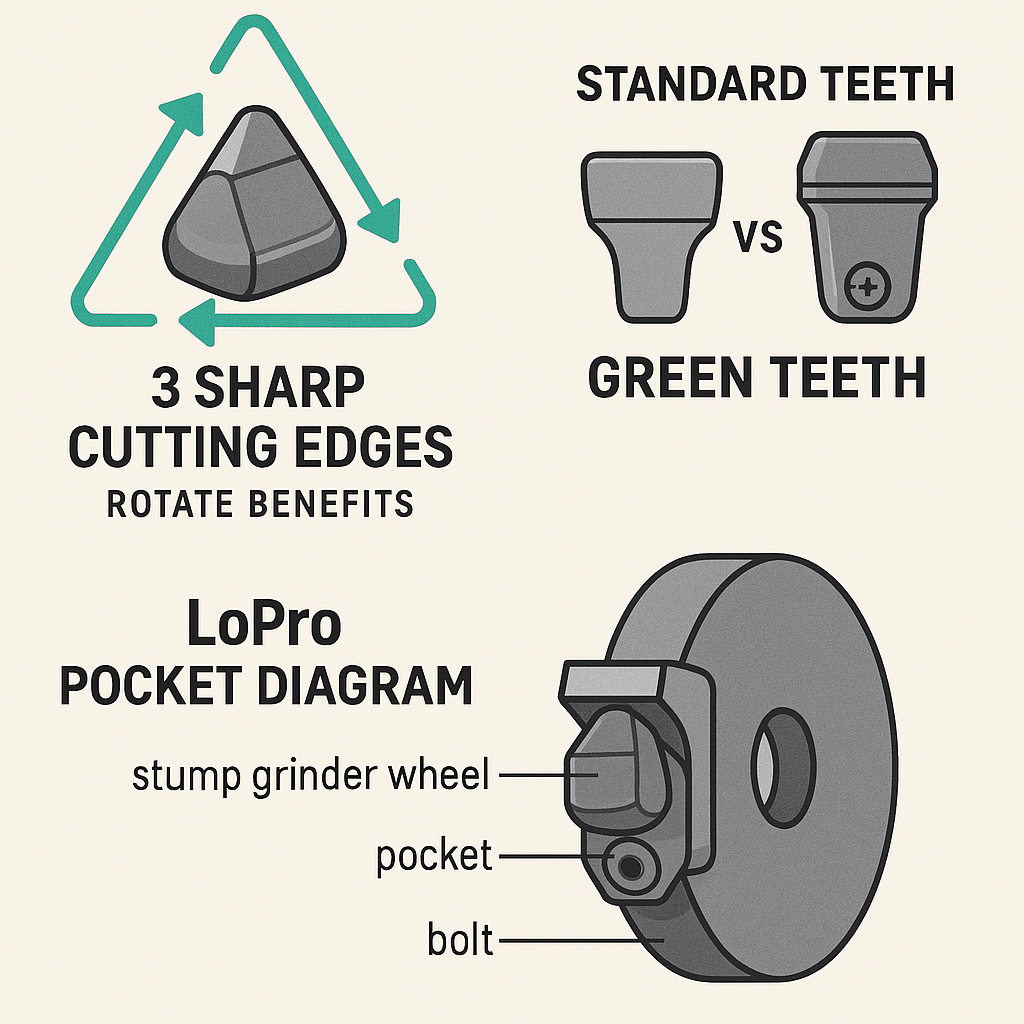
Experience Faster Grinding: The Efficiency Edge of Green Teeth
Many people find that Green Teeth speed up their stump-grinding work.
The special shape of the teeth helps them bite into the wood effectively.
The LoPro pocket system, a common type, also helps.
Its lower profile means less metal dragging through the wood chips.
This can lead to a smoother, faster cut.
What Users Say:
“Switched to Green Teeth on my grinder last year. Huge difference. Cuts through oak much faster than the old teeth.” (Paraphrased from online forum comment)
Lots of videos online show Green Teeth in action.
You can often see grinders fitted with them chewing through stumps quickly.
Some users report cutting times reduced by up to 20% compared to basic teeth.
However, Speed depends on a few things:
- Grinder Power: A bigger, more powerful grinder will always be faster.
- Wood Type: Soft woods like pine grind faster than hardwoods like oak.
- Tooth Type: The Wearsharp type of Green Tooth is designed to stay sharp longer, potentially keeping cutting Speed high.
- Ground Conditions: Hitting rocks or dirt will slow any tooth down.
While Green Teeth often start very fast, the most significant time saving comes from their long life and easy rotation.
Maximise Uptime: The Rotatable Design for Extended Tooth Life
This is probably the most significant advantage of Green Teeth.
Think about a normal stump grinder tooth.
It usually has just one cutting edge.
When that edge gets dull or damaged, the whole tooth is finished.
You have to stop work and replace it.
Green Teeth are different. Each standard tooth has three identical cutting edges.
Imagine a triangle – each point is a sharp edge.
You use one edge until it starts to feel blunt.
Then, you loosen the bolt, holding it in the pocket.
You rotate the tooth 120 degrees.
A fresh, sharp edge is now ready to cut.
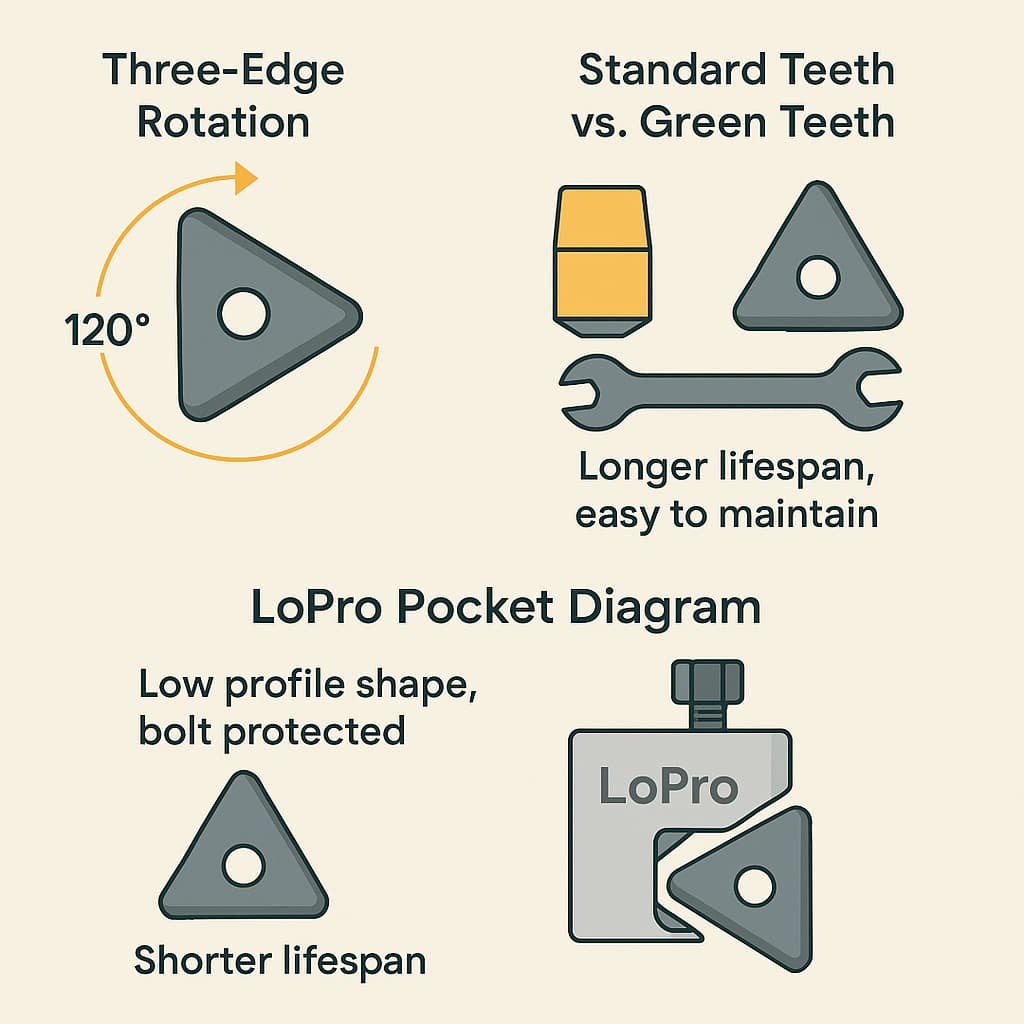
You tighten the bolt, and you are back to grinding quickly.
You can do this twice before the tooth is completely used up.
So, one Green Tooth effectively gives you three lives.
Real-World Lifespan:
How long does each edge last? This varies a LOT. It depends on:
- What are you grinding (hardwood, softwood, roots)?
- How many rocks or stones are in the soil?
- The power of your grinder.
- How the operator uses the machine.
Some users on forums like ArboristSite or TreeBuzz report getting:
- 8-15 hours per edge in harsh, rocky conditions.
- 15-25+ hours per edge in cleaner, softer wood conditions.
Important: These are just estimates from users. Your results could be different.
Even at the lower end, getting 24 hours (3 edges x 8 hours) from one tooth is much better than many single-edge teeth.
This massively reduces how often you need to buy new teeth.
It also means less time spent stopped changing worn-out teeth during a job.
Simplify Maintenance: Discover the Ease of Changing and Rotating Green Teeth
Changing or rotating Green Teeth is famously quick and easy.
Most older systems need you to undo two bolts per tooth.
Sometimes, these bolts are hard to reach or get stuck.
It could take a long time to change a whole set of teeth.
The Green Teeth system typically uses just one bolt (or nut) per tooth.
This bolt goes into the pocket that holds the tooth.
Here’s how easy it is:
- Use the wrench (spanner) of the correct size.
- Loosen the nut/bolt just enough to turn the tooth.
- Rotate the tooth to the next sharp edge.
- Tighten the nut/bolt securely. Done!
If you need to replace the whole tooth, undo the bolt fully, swap the tooth, and retighten.
Many online videos show people rotating a whole set of Green Teeth in 10-20 minutes.
Compare this to an hour or more for some older systems.
Why this matters:
- For Professionals: Less downtime means more jobs completed per day or week. Time saved on maintenance is time-earning money.
- For Hire Customers: If a tooth gets dull mid-job, rotating it is simple. They don’t need special tools or many mechanical skills, which leads to fewer frustrated calls to the hire shop.
“Changing teeth used to be the worst job. The Green Teeth system is brilliant. I can rotate them all during a quick tea break.” (Typical sentiment from user reviews)
This ease of use is a significant selling point for grinders fitted with Green Teeth.
Decoding the Design: How Green Teeth Technology Works
Let’s look closer at the parts that make Green Teeth special.
It’s mainly about the pocket and the tooth shape.
The Innovative Pocket System Explained (LoPro Focus)
The pocket is the metal holder bolted to the grinder wheel.
The Green Tooth sits inside this pocket.
Green Manufacturing designed these pockets carefully.
They are shaped to protect the bolt that holds the tooth.
The design aims to reduce the bolt’s sideways forces (shear stress).
This helps prevent bolts from snapping, especially if you hit something hard.
The pockets are also designed to be worn slowly.
The LoPro series is a prevalent pocket type.
“LoPro” stands for Low Profile.
This means the pocket itself is pretty slim.
It doesn’t stick out much from the grinder wheel.
This helps in a few ways:
- Less Drag: The slim pocket moves more easily through the wood chips.
- Better Chip Flow: Allows ground material to clear away efficiently.
- Improved Cutting: Less resistance can mean smoother, faster grinding.
These pockets are key to why the Green Teeth system works so well.
Rotating Cutting Edges: The 120-Degree Advantage
We talked about the three cutting edges.
The tooth itself is usually made from tungsten carbide.
Carbide is an extremely hard material, ideal for cutting tough materials like wood.
The tooth is shaped so that when it sits in the pocket, one of the three edges faces the wood.
The 120-degree rotation is simple geometry.
A circle is 360 degrees. Dividing it by three gives 120 degrees.
Each turn presents an entirely fresh edge to the work.
This simple, innovative design is the heart of the Green Teeth advantage.
It means less waste and more cutting from each piece of carbide.
Introducing Wearsharp™ Teeth: Do They Stay Sharper Longer?
Green Manufacturing also makes a special type of tooth called Wearsharp.
These look slightly different from the standard Green Teeth.
They have a concave shape on the cutting face (it curves inwards slightly).
Standard teeth usually have a flat face.
The idea behind Wearsharp is clever.
As the concave edge wears down, the shape helps it maintain a sharper point for longer.
Think of how a chisel wears: Wearsharp tries to avoid getting flat and blunt.
It aims to be worn in a way that keeps a useful cutting-edge working longer.
Manufacturer Claims vs. User Observations:
Green Manufacturing states that wearing sharp teeth provides sustained sharpness.
Many users agree they cut aggressively for longer between rotations.
They often report maintaining good cutting speed for more hours per edge than standard Green Teeth.
Potential Trade-offs:
Because the carbide edge is shaped differently, some users feel Wearsharp teeth might be slightly more likely to chip or break if they hit a rock directly.
The sharper profile might be less forgiving of impacts compared to a blunter, standard tooth.
However, many professionals use Wearsharp successfully, even in mixed conditions.
They are often preferred for cleaner wood or where maximum cutting speed is desired.
Choosing between standard Green Teeth and Wearsharp often depends on the typical grinding conditions and user preference.
Durability in Action: How Green Teeth Withstand Grinding Challenges
Stump grinding is challenging work. Teeth need to be durable.
Assessing Overall Toughness and Wear Resistance
Green Teeth are generally considered very durable.
The carbide used is high quality.
The pocket system helps protect the bolts and the wheel.
As discussed earlier, users consistently report a good lifespan (8-25+ hours per edge, depending on conditions).
Simply rotating away minor edge damage is also a big plus.
A small chip on one edge doesn’t mean the whole tooth is scrap.
Tackling Tough Conditions: Performance Against Rocks and Debris
No stump grinder tooth likes hitting rocks, concrete, or hidden metal.
Carbide is very hard but also brittle.
A sharp impact from a hard object can chip or break any carbide tooth, including a green tooth.
This is an unavoidable risk in stump grinding.
Pocket Protection:
The Green Teeth pocket design can help absorb some impact.
It might offer slightly more protection to the expensive grinder wheel than other systems.
If a tooth breaks, it’s usually just the tooth that needs replacing.
Cost of Damage:
Replacing a single damaged Green Tooth is relatively easy.
While not cheap, the cost is manageable compared to replacing teeth on some older, more complex systems.
Many operators accept occasional tooth damage as part of the job cost.
They feel the overall performance and ease of use of Green Teeth outweigh the risk of breakage.
“Hit a hidden brick the other day. Snapped one Wearsharp tooth clean off. It’s annoying, but it took 2 minutes to put a new one on. The pocket and wheel were fine.” (Example from online discussion)
Common Problems Summary Box
- Rock Damage: The main enemy is hitting rocks or hard debris. It can chip or break teeth (especially Wearsharp). Solution: Grind carefully, check the area first, and replace damaged teeth promptly.
- Bolt Loosening: Bolts can sometimes work loose with vibration. Solution: Check bolt tightness regularly (e.g., daily). If you have a torque wrench, use the correct torque setting.
- Bolt Snapping: This can happen with very hard impacts or if bolts are over-tightened or loose. Solution: Use the correct torque to avoid reckless grinding. Replace snapped bolts immediately.
- Pocket Wear: Overtime (hundreds of hours), the pockets will wear where the tooth sits. Solution: Inspect the pockets when changing teeth. Replace worn pockets to ensure teeth sit correctly and securely.
Analysing the Investment: Are Green Teeth Cost-Effective?
Green Teeth often cost more upfront than basic, standard teeth. But are they worth the money?
Understanding the Initial Purchase Price
A complete set of Green Teeth and pockets to convert a grinder can be a significant investment.
Individual replacement teeth also cost more than some basic alternatives.
You must compare the price against the teeth that come standard on your grinder or other aftermarket options.
Calculating Long-Term Value: Savings on Time and Replacements
Most users feel Green Teeth provides excellent long-term value. Here’s why:
- 3x Tooth Life: Getting three edges per tooth drastically reduces the number of replacement teeth you need to buy over time.
- Reduced Labour Time: Minutes saved rotating teeth instead of struggling with old systems add up. If you pay staff, this is a direct cost saving. If you do it yourself, it’s valuable time saved.
- Faster Job Completion: If Green Teeth help you grind faster, you can fit more jobs into a day or week, increasing potential earnings.
- Less Downtime: Quick changes mean the grinder works more and sits idle less.
Hypothetical Example:
Imagine a small tree company:
- They upgrade one grinder to Green Teeth 900 Series.
- Initial Cost: £600 (example figure for teeth & pockets)
- Time Saved Rotating vs. Old System: 30 minutes per week.
- Labour Cost: £20 per hour. Weekly Labour Saving: £10.
- Faster Grinding: Assume one extra small stump (£50 profit) per week due to speed/efficiency.
- Reduced Tooth Cost: Saves £200 per year on replacements.
Weekly Benefit: £10 (labour) + £50 (extra job) = £60 Annual Replacement Saving: £200
In this simplified example, the £600 investment could be paid back in roughly 10 weeks from time savings and extra work, plus the ongoing savings on replacement teeth.
Conclusion on Cost: While the initial price is higher, the benefits of longer life, faster work, and easier maintenance make Green Teeth cost-effective for most professional users and high-volume hire situations.
Green Teeth for Stump Grinder Hire: Why It Matters to You
If you’re looking to hire a stump grinder, you might wonder if the type of teeth matters. It does!
Seeing a hire machine equipped with Green Teeth is often a good sign.
Here’s why it benefits you as the hirer:
- Reliability: Green Teeth last longer per edge. This means you’re less likely to get a machine with dull teeth right from the start.
- Performance Consistency: A machine with sharp Green Teeth (especially if recently rotated) will likely grind efficiently, helping you finish your job faster.
- Less Hassle: If an edge does get dull during your hire period, rotating it is simple. Most hire companies can show you how, or you can find videos online. It requires minimal tools and time.
- Potentially Better Maintained Machine: Hire companies who invest in upgrades like Green Teeth often take good care of their equipment overall.
Think of it like hiring a car. One with good quality tyres is likely safer and performs better.
A grinder with Green Teeth suggests the hiring company cares about performance and making the job easier for you.
It reduces the chance you’ll spend your hire time fighting with blunt or broken teeth.
Ask the Hire Company: When booking, ask if their grinders use Green Teeth or a similar quality system. It can make a difference to your experience.
Choosing the Right Set: Understanding Green Teeth Series (700, 900, 1100)
Green Teeth comes in different sizes and Series.
These usually match the size and power of the stump grinder.
- 700 Series: Typically for smaller grinders (e.g., up to 25-30 horsepower). They are physically smaller teeth and pockets.
- 900 Series: A widespread size for mid-range professional grinders (e.g., 25-70 horsepower). A good balance of size and strength.
- 1100 Series: For larger, high-horsepower grinders (e.g., 70+ horsepower). These are the most significant and most challenging options for heavy-duty work.
There are other Series, too, but these are frequently mentioned.
Compatibility:
Using the correct Series and power rating for your grinder wheel is crucial.
Using teeth too small for a powerful machine can lead to breakages.
Using teeth that are too large might not fit or could put extra strain on the grinder.
Most suppliers list which grinders each Series is suitable for.
If unsure, always check with the manufacturer or a knowledgeable dealer.
They can help you choose the right pockets and teeth Series for your machine model.
Getting the Best Results: Key Installation and Maintenance Tips
To get the most out of your Green Teeth, follow these simple tips:
- Correct Torque: This is important! Tighten the bolt/nut holding the tooth securely, but do not overtighten. Overtightening can stretch or break the bolt. It is best to use a torque wrench set to the manufacturer’s recommendation. If you don’t have one, tighten firmly, but don’t swing on the wrench with all your might.
- Regular Checks: Vibration can loosen bolts over time. Briefly check tooth bolt tightness before each use or at least daily. A quick visual check and a nip with the wrench take seconds.
- Keep Pockets Clean: Quickly clean out dirt or grit inside the pocket when rotating or changing teeth. This helps the tooth sit correctly and securely.
- Ensure Proper Fit: Before tightening, make sure the tooth sits flat and snug in the pocket. A poorly seated tooth won’t cut effectively and might damage the pocket or bolt.
- Rotate Regularly: Don’t wait until an edge is completely rounded or broken. Rotate the teeth when you feel the cutting performance start to drop off. This maximises the life of all three edges.
- Inspect Pockets: Occasionally, look at the pockets for signs of wear or damage, especially where the tooth sits. Worn pockets should be replaced.
Following these steps helps ensure safety, performance, and the most extended possible life from your Green Teeth system.
Acknowledging the Limitations: Potential Downsides of Green Teeth
While highly regarded, Green Teeth aren’t perfect. It’s fair to mention potential drawbacks:
- Higher Initial Cost: As discussed, buying a complete set of Green Teeth and pockets costs more upfront than basic teeth. This can be a barrier for some budgets.
- Rock Sensitivity: All carbide teeth hate rocks. Direct impacts can cause chips or fractures. Some feel the Wearsharp profile might be slightly more vulnerable due to its shape. Careful operation is always needed.
- Bolt Issues (If Neglected): While the design helps protect bolts, they can still loosen or shear if not checked regularly or subjected to severe, repeated impacts. Proper maintenance is key.
- Pocket Replacement Cost: Pockets are durable but don’t last forever. After hundreds of hours of grinding, they will eventually wear out and need replacing, which adds to the long-term running cost.
For most users, the benefits heavily outweigh these points. However, it’s good to be aware of them.
User Voices: What UK Arborists and Landscapers Think (Forum & Video Insights)
We’ve gathered feedback from places where professionals chat, like online forums (ArboristSite, TreeBuzz) and YouTube comments. Here’s a summary of what they often say:
Common Praises:
- “Game Changer”: Many say switching to Green Teeth significantly improves their grinding operation.
- “So Much Faster to Change”: The ease of rotation/replacement is mentioned constantly as a significant plus.
- “Worth the Money”: Despite the cost, experienced users overwhelmingly feel the investment pays off in the long run.
- “Good Cutting Speed”: Especially with Wearsharp, users often report fast and smooth cutting.
- “Long Lasting”: The three-sided design gets praise for extending the time between buying new teeth.
Common Criticisms / Things to Watch For:
- “Watch Out for Rocks”: Users are always cautious about avoiding hidden debris.
- “Check Bolt Torque”: Experienced operators stress the importance of regular bolt checks.
- “Wearsharp Can Chip”: Some note that Wearsharp might chip more easily than standard teeth on hard impacts.
- “Pockets Wear Eventually”: Long-term users acknowledge that pockets need replacing over time.
Table: User Feedback Summary
| Feature | Common Positive Feedback | Common Negative Feedback/Cautions |
|---|---|---|
| Cutting Speed | Often faster than standard, smooth cut (esp. Wearsharp) | Dependent on grinder HP, wood type |
| Tooth Life | 3 edges = much longer life, fewer replacements needed | Hours per edge vary hugely based on conditions |
| Ease of Change | Extremely easy & fast (single bolt), saves huge time | Bolts need regular checking for tightness |
| Durability | Generally tough, pocket protects bolt & wheel | Vulnerable to rock impacts (carbide is brittle) |
| Cost | High initial price | Excellent long-term value, saves money over time |
| Wearsharp Teeth | Stay sharp longer, aggressive cut | Might chip more easily on direct rock hits |
| Pocket System | Good design, protects components, LoPro reduces drag | Pockets wear out eventually and need replacement |
Most user feedback is highly positive, particularly from those who use stump grinders regularly for their business.
The Verdict: Should You Opt for Green Teeth on Your Stump Grinder?
So, after looking at all the details, what’s the final word on Green Teeth?
They offer real advantages for almost anyone using a stump grinder.
The key benefits are clear:
- Efficiency: Potential for faster grinding.
- Longevity: Three cutting edges per tooth mean a much longer life.
- Ease of Use: Rotating or changing teeth is effortless and fast.
These factors combine to save time and money in the long run.
While the initial cost is higher than basic teeth, the reduction in downtime, the extended life between replacements, and the potential for quicker job completion make them a wise investment for professionals.
Choosing a machine fitted with Green Teeth can make hiring a stump grinder more productive and less frustrating.
Actionable Steps:
- Assess Your Needs: If you grind stumps often, consider upgrading to Green Teeth.
- Check Compatibility: Ensure you choose the correct Series (700, 900, 1100, etc.) for your grinder model.
- Factor in Long-Term Value: Look beyond the initial price tag and consider the savings over time.
- Hiring? Ask About Teeth: Specifically, ask hire companies if their grinders use Green Teeth for potentially better performance.
Looking to hire a stump grinder equipped with Green Teeth?
✅ Check our local listings across the UK
✅ Fast, powerful machines from trusted hire centres
✅ Get the job done right — with sharper, longer-lasting teeth

